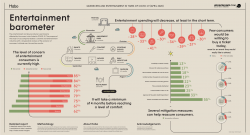attendance trends
What Do Gen Z in Canada Think About the Performing Arts?
Guest writer, Lila Galipeau, recaps the Gen Z session at Confluence 2023. She shares how the new generation engages with the performing arts.
Audiences need to be reminded of the benefits of attending
Mental health and trying something unique or different are among the top benefits that may compel audiences to attend live performances.
Performing Arts, Tourism and the Experience Economy: The Untapped Potential
Research shows that amongst travellers, there is a growing desire for authentic experiences that enliven and deepen connections to place. Live events and festivals provide these types of experiences year round.
Breaking through audience hesitancy
Consumers’ levels of comfort with in-person events are closely tied to vaccine rollout and fluctuations in the number of cases. This is particularly true among performing arts audiences.
Vaccination: how do culture goers feel about it?
CAPACOA recently held a fascinating town hall on the theme On the Path to Recovery: Are Mandatory Vaccines for Audiences in the Mix? As a complement to the recap of this discussion, here are recent findings about culture goers’ attitudes regarding vaccination.
Online performances remain a valuable alternative for many cultural consumers
More and more cultural consumers have watched and paid for online performances. For these consumers, "free" is a poor value proposition.
Online Performances And The Search for a Viable Business Model
Can the changes in the way we create and consume art in this era reshape the performing arts sector? Find answers from our two-part webinar.
Canadian Art Goers are Longing for Live Events
Audiences are yearning for live performances, and the demand for online performances might very well decrease once in-person events resume. This is what consumer surveys conducted in Alberta and Ontario are indicating.
Is age a significant factor in patrons’ intention to return to the performing arts?
Many audience survey reports were released over the last two months. CAPACOA read them and looked for conflicting and converging findings regarding age, comfort levels and reassuring measures. So? Does age matter?
Online cultural offerings satisfy audiences’ cravings… for now
A lot of people enjoyed live-streamed performances since the beginning of the COVID crisis. But they may not continue when venues reopen.
What will make audiences feel safe to return to live performances?
Consumer surveys provide valuable information about audiences' attitudes towards various safety precautions.
The long wait for audiences
The entire live performance sector wonders: “When we’re allowed to reopen, will audiences come back?” Consumer surveys north and south of the border provide many nuanced, and very useful, answers.
Live Performances: the Social Paradox and the Welcoming Factor
June 7, 2019 – According to Canadian audience research, the social aspects of a live performance experience can both encourage and hinder attendance. Here’s a recap of a recent web conference during which facilitator and participants sought to make meaning of this social paradox. The Social Conundru...Read More
Living Solo / Being Social – Social Aspects of Arts Participation
April 8, 2019 – More and more Canadians are living alone. In 2016, for the first time, one-person households became the most common type of household in Canada, surpassing couples with children. Should this be seen as a concern or as an opportunity for performing arts organizations, whose offering i...Read More
The Cultural Participation of New Canadians
October 15, 2018 – Immigration is changing Canada’s demographics. Fast. It is also changing cultural participation and perceptions about culture.
Attendance Trends: Where Are Performing Arts Audiences?
March 12, 2018 – As the demographics of the Canadian population change, so are their habits for accessing live performances and other forms of entertainment. In this last article of the “Attendance Trends” series, we will look at preferred locations for live performance attendance.
Attendance Trends: Captivating Millennial Audiences (part 2)
January 30, 2018 – In a previous article, we established that the Millennial generation is particularly diverse with regards to social values and immigration, and that Millennials are equally or more culturally active than any previous generation. Millennials also have a few singularities when it co...Read More
Attendance Trends: Captivating Millennial Audiences (part 1)
January 16, 2018 – As the demographics of the Canadian population change, arts organizations find themselves challenged in retaining current audiences while attracting new ones. The question of attendance of the performing arts by Millennials, in particular, has been receiving some attention as of l...Read More
Attendance Trends: Why Won’t They Come?
November 29, 2017 – National surveys find widespread attendance of the performing arts among the Canadian population. Yet, many series presenters are finding it more and more difficult to fill up their house. It’s a hard gap to explain, but a few answers could lie in reported obstacles to attendance...Read More















